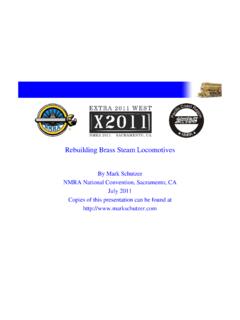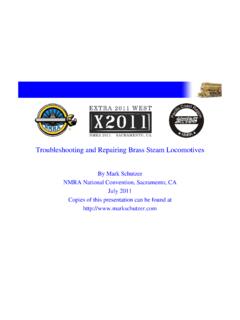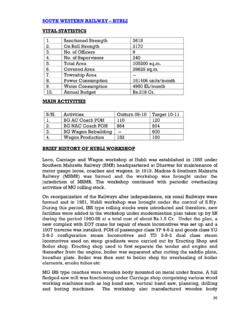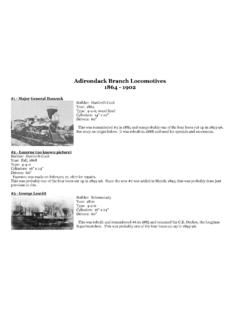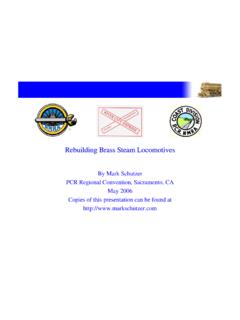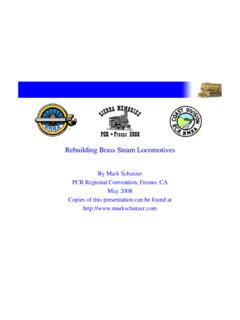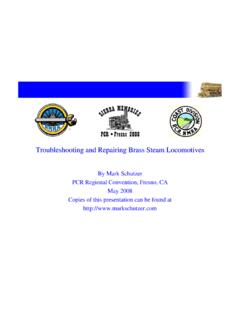Transcription of Improving a Klein Modellbahn Reihe 56 Steam Locomotive ...
1 Improving a Klein Modellbahn Reihe 56 Steam Locomotive with a Lenz Gold Decoder and P1-Module Klein Modellbahn in Austria makes manufactures highly detailed Locomotive and car models of the Austrian federal railroad ( BB) and neighboring countries. The first super model from Ing. Klein was the Reihe 170 of the kkStB, a 1D n2 Steam Locomotive with tender, later by the BB designated as Reihe 56. The highly successful original was designed by the famous Austrian Locomotive designer Karl G lsdorf in 1897, and more than 1000 were built in Europe. The model is equally excellent, but the early ones suffer from a small but annoying design flaw: there were no electric pickups in the motorized tender, and due to un-sprung axles in the stiff engine frame, the Locomotive stalls easily on switches, and over uneven or dirty track, particularly so under DCC operation.
2 An elegant but relatively extensive solution by completely rebuilding the tender has been presented in Modellbahnwelt 3/2005. There is, however, a simpler way to transform the early KMB 56 into well-running digital model by installing a Lenz Gold Decoder with Power-Module. The Power-Module is in principle a high capacity super-capacitor, which rapidly charges under normal operating conditions and supplies the necessary power when contact to the track is interrupted (Figure 1). Figure 1: The Lenz Gold Decoder as delivered with P1 Power-Module soldered to the board. Unfortunately, there is insufficient space under the coal bunker extension to accommodate the decoder and the additional round P1 module (also partly due to a particularly large NEM 362 female connector in the tender).
3 The simplest solution, to extend the coal bunker boards up to the full clearance profile is neither prototypical nor estethically satisfying. However, for operation on mountain railroads with many and long tunnels (for example the Austrian Arlberg pass line), many locomotives of the 170/56 series were equipped with supplemental oil firing, necessitating an additional oil tank on the tender. The inside of the tank is ideally suited to accommodate the round P1 module. The modification is not difficult, and starts with the search for a suitable tank. Prototype photographs exist which show tenders with the supplemental oil tanks, and one could build one from the scratch from brass . A much simpler solution is to search the scratch and wreckage box for suitable parts.
4 I found a beer container from a broken Klein container car. With some filing and supplied with a tank cover from a hopper a plausible tank can be assembled. The base of the tender also has to be filed or milled out to accommodate decoder, and also the coal bunker extension needs to be trimmed up to the boards (detailed in Figure 2). Figure 2: The modified Kleinbahn beer container (top) and the trimmed tender housing (left) and milled out extension coal frame (right). Next, a small supporting frame made from polystyrene strips is glued into the coal bunker frame, and the tank glued on top. The excess pats are milled out with a small hand tool as much as possible to accommodate the rather large P1-module (Figure 3). Figure 3: The coal bunker extension, with frame and tank, is milled out to accommodate the P1-module.
5 Finally, the leads to and from of the decoder must be shortened. If a Lenz Gold decoder with JST-type connector is used, the connector needs to be removed and the leads directly soldered to the decoder board. This is relatively easy with a small electronics soldering needle, but clean soldering iron and a steady hand are necessary to avoid formation of any solder bridges between the small contact pads (Figure 4). Figure 4: The decoder after removal of the JST connector and shortened wires After a functional test of the decoder and the P1-module, the flat black painted tender extension can be placed over the electronics and the Reihe 56 is ready for the first test run (Figure 5). It is important to set the duration of the power supply to maximal, which is done in programming mode by setting CV 122 to 255 (the default value is rather low).
6 Figure 5: Decoder and P1-Modul fitted in the tender Using these CV value, the 56 conquered nearly 8 inches of paper without stopping (Figure 6). The whole modification can be accomplished in about 3-4 hrs with regular modeling tools and a decent electronics soldering station, no special tools are required. The decoder and the P1-moduel are available from Tony s Train exchange for about 76 US dollar. Figure 6: The Klein Modellbahn Reihe56 conquers without trouble about 8 inch of covered track. A short movie that shows the modified 56 conquer a piece of paper covered track can be downladed from Figure 7: the finished tender with supplemental oil tank in detailed view.
